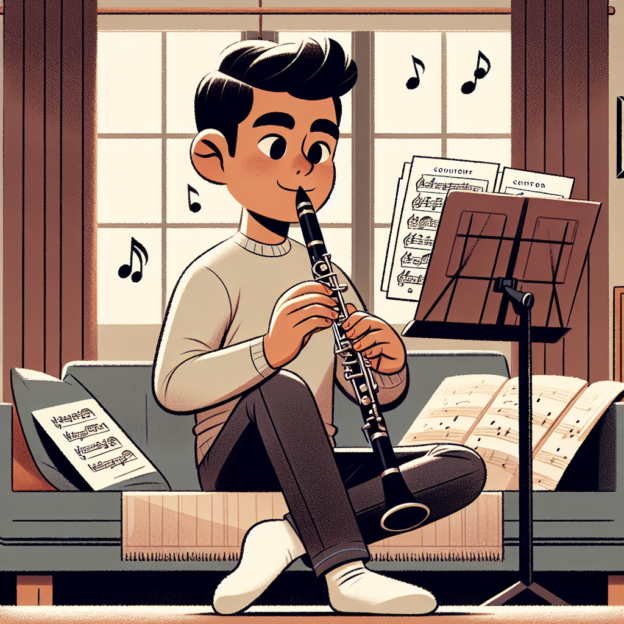One of the most important and often overlooked skills in playing the clarinet is proper tongue placement for articulation. To create clean, precise notes, your tongue's position and movement are just as important as your embouchure or finger technique. Let's break this down into simple, actionable steps to help you improve your playing, whether you're just starting out or have been playing the clarinet for years!
Think about it this way—every time you articulate a note, your tongue controls the airflow. Too much pressure, and your tone suffers; too little pressure, and you might lose control. It's all about balance. But where exactly should your tongue go? The standard practice is placing the tip of your tongue very lightly on the reed at or near its very tip. But don't poke or jab! This gentle touch is what creates that light, crisp articulation that so many players aim for.
Developing proper tongue placement starts with awareness. Begin with long tones and experiment gently with lightly touching the reed. Feel where the motion is coming from—is it your neck? Your jaw? Ideally, your tongue should move independently without big movements in your throat or jaw. Recording yourself during practice can be eye-opening. Often, players don't realize they're moving more than needed until they listen back.
Common Mistakes in Tongue Placement
A frequent error is pressing the tongue too hard against the reed, which “chokes” the sound. If this happens, think of the tongue as a whisper—light, deliberate, and just enough to say the word “du” against the reed. This mental image can help reset habits, especially if you've been over-articulating.
| Mistake | Correction |
|---|---|
| Pressing too hard | Think of a whisper, light touch |
| Moving jaw/throat | Focus on independent tongue movement |
| Inconsistent placement | Practice awareness and consistency |
Tips for Beginners
For beginners, start slow. Single tonguing is typically the first step when learning articulation. Practice with simple exercises like tonguing each repetition of quarter notes while using standard metronome tempos. Gradually work up to faster and more advanced patterns, like sixteenth notes or even staccato triplets, all while maintaining that steady, light motion of the tongue.
Advanced Techniques
For advanced players, double tonguing and flutter tonguing may be part of your skill set. Mastering these starts with perfecting single articulation. Double tonguing alternates between “du” and “gu” sounds, where the back of the tongue plays a more active role alongside the tip. This technique opens up many possibilities for pieces with rapid passages. The key? Practice slowly before increasing speed and don't worry about immediate perfection. It's a long-term process, not a race!
The Role of Instrument Setup
Ever wonder why tongue placement can feel different from one day to the next? Your instrument setup can be a big factor! Mouthpiece design, reed strength, and even the clarinet itself all influence how natural articulation feels. Brands like Martin Freres Clarinets are made to maintain consistent intonation and response, which can make refining your technique easier. Choosing equipment that suits your playing style can make a big difference.
The Power of a Warm-up Routine
While setup is important, don't underestimate the value of a focused warm-up routine. Spend at least 10 minutes a day on articulation exercises. Try mixing it up with slurred connecting phrases and single-tongued repetitions to test control in both areas. Some players find it helpful to imagine a straw in their mouth during tonguing to align airflow and tongue placement just right.
Breathing and Articulation
Having trouble with articulation in faster passages? Your breathing might be the issue. A step often missed in practice is coordinating breath support with tongue motion. Strong support from your diaphragm keeps the air steady, helping each articulation sound clear. Even experienced players sometimes need to go back to basics—a small change in focus can lead to quick improvements.
Don't Forget Musicality
Remember to keep musicality in mind during technical practice. It's easy to get caught up in “making it perfect” rather than adding character to each note. Every articulation exercise is a chance to work on dynamics, phrasing, and your personal style. Think of your tonguing as another way to express emotion and tell a story through your music.
Teaching Articulation
For young clarinetists or anyone teaching students, articulation games can make repetitive practice more fun! Use phrases from popular songs or even say silly phrases like “hot potato” or “tick-tock” while mimicking how the tongue would move with the reed. This approach connects verbal sounds to physical movement, often making the process less daunting.
The Importance of Consistency
Consistency is key for every player! Building muscle memory for articulation takes time and patience—and yes, some trial and error. Stay curious as you practice, write down your breakthroughs in a practice journal, and don't get discouraged by mistakes—laugh them off instead!
By slowly putting these tips into practice and finding what works for you, you'll naturally improve your accuracy and articulation. Who knows, in a few months, your friends or fellow musicians might be coming to you for advice!
A Word of Encouragement
On challenging music days, remember: clarinetists of all levels—professionals and hobbyists alike—face similar struggles. Your journey with the instrument is unique, and every squeak or misarticulation is part of the learning process. If the great clarinet players of the past could share their wisdom, they'd remind us that the magic lies in persistence and small, steady improvements. Keep practicing, and enjoy the beauty of what you're creating, one note at a time.







